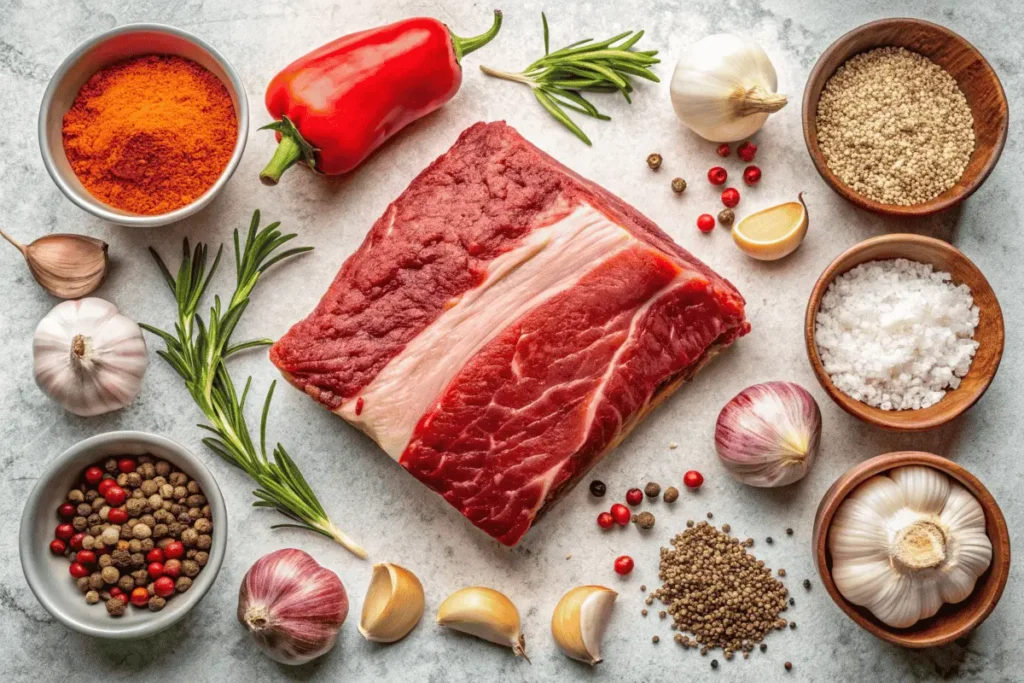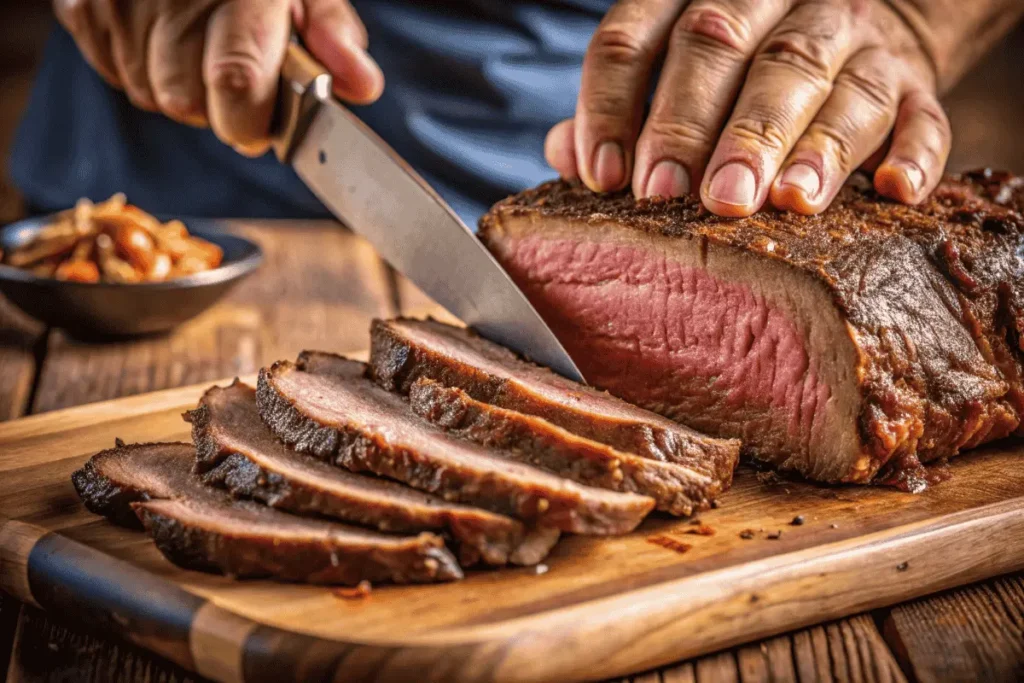There’s something undeniably comforting about the aroma of slow-cooked meat filling the kitchen, a promise of a meal that’s both hearty and deeply satisfying. Today, we’re diving deep into the world of beef, exploring the question on every meat lover’s mind: [is Beef Brisket a Good Cut of Meat]? Brisket isn’t just any old piece of beef; it’s a culinary adventure, a journey from a tough cut to a tender, flavorful masterpiece. Did you know that brisket was historically considered a less desirable cut? But thanks to the magic of slow cooking, it’s been transformed into a star of the BBQ scene. It’s a testament to the power of patience and proper preparation!
This isn’t just a recipe; it’s your guide to mastering brisket, a tough cut that transforms into succulent, flavorful perfection. Like our popular Slow Cooker Pulled Pork, brisket offers a melt-in-your-mouth texture. It requires patience, but the results are worth it. Get ready to explore the wonders of brisket!
Rewritten “What is Beef Brisket?” Paragraph:
Brisket is a hardworking muscle from the cow’s chest, known for its toughness. But don’t worry! This toughness is the key to its incredible flavor when cooked right. They say food is the way to the heart, and brisket is no exception. Forget what you know about tough cuts—prepare for a delicious transformation! Let’s see why [is Beef Brisket a Good Cut of Meat].
Rewritten “Why You’ll Love This Beef Brisket” Paragraph:
Brisket’s slow-cooked flavor and fall-apart texture are the main draw—it’s more than a meal, it’s an experience! Cooking brisket at home is budget-friendly, allowing you to feed a crowd without overspending. Plus, brisket is incredibly versatile; from classic BBQ to bold spices, the flavor possibilities are endless. If you loved our Smoked Ribs, you’ll appreciate the magic of making brisket. So, let’s get cooking!
How to Make Beef Brisket:
Quick Overview
Brisket isn’t a complicated dish; it’s more of a patient one. The magic happens with slow cooking, allowing the connective tissue to break down and create an unbelievably tender and juicy result. We’re talking about a cut of meat that transforms from tough to heavenly with just a bit of time and care. This method will give you the most amazing beef you’ve ever tasted. The preparation is minimal, and the cooking is hands-off, making it a perfect dish for weekend gatherings or when you want something special without spending hours in the kitchen. Get ready to enjoy a rich, flavorful, and incredibly satisfying meal – perfect for any occasion!
Key Ingredients for Beef Brisket:

- 3-4 lb Beef Brisket: Look for a brisket with good marbling (streaks of fat within the meat).
- 2 tbsp Coarse Salt: Kosher or sea salt works best.
- 2 tbsp Black Pepper: Freshly ground for the best flavor.
- 1 tbsp Garlic Powder: Adds a savory base.
- 1 tbsp Onion Powder: Enhances the depth of flavor.
- 1 tsp Paprika: Sweet or smoked, depending on your preference.
- 1/2 tsp Cayenne Pepper (Optional): For a touch of heat.
- 1 cup Beef Broth: Adds moisture and flavor during cooking.
- 1 tbsp Olive Oil (Optional): For searing (optional).
Step-by-Step Instructions:
- Prep the Brisket: Remove the brisket from the packaging and pat it dry with paper towels. This helps the seasoning adhere better. Trim off any excess hard fat, leaving a thin layer for moisture and flavor.
- Mix the Rub: In a small bowl, combine the coarse salt, black pepper, garlic powder, onion powder, paprika, and cayenne pepper (if using). Mix well to ensure even distribution. This rub is the heart of your flavor!
- Season the Brisket: Generously rub the seasoning mixture all over the brisket, making sure to cover every inch. Don’t be shy; really massage the rub into the meat. This will create a delicious crust during cooking.
- (Optional) Sear the Brisket: Heat the olive oil in a large, heavy-bottomed pot or Dutch oven over medium-high heat. Sear the brisket on all sides until nicely browned, about 2-3 minutes per side. This adds an extra layer of flavor and creates a beautiful crust.
- Add the Beef Broth: Pour the beef broth into the pot, around the brisket. You don’t need to submerge the brisket entirely; about 1 inch of liquid at the bottom is perfect.
- Slow Cook the Brisket: Cover the pot tightly with a lid, or wrap with foil. Place it in a preheated oven at 275°F (135°C). Cook for 4-6 hours, or until the brisket is fork-tender. If using a slow cooker, set it on low for 8-10 hours. The cooking time can vary based on the size and thickness of your brisket, so be sure it is fork-tender before removing it from the heat
- Rest the Brisket: Remove the pot from the oven or slow cooker and let the brisket rest, still covered, for at least 30 minutes. This allows the juices to redistribute, resulting in a more tender and flavorful final product.
- Slice and Serve: Carefully remove the brisket from the pot. Slice it against the grain with a sharp knife for maximum tenderness. Serve hot and enjoy!

What to Serve Beef Brisket With:
Brisket is wonderfully versatile and pairs well with a variety of side dishes. Here are some ideas:
- Classic BBQ Sides: Creamy coleslaw, potato salad, macaroni and cheese, baked beans, and cornbread are all wonderful accompaniments.
- Fresh Vegetable Sides: Roasted vegetables like asparagus, carrots, or Brussels sprouts provide a nice contrast. A fresh green salad also works great.
- Starches: Mashed potatoes, roasted potatoes, or rice can help soak up all the delicious brisket juices.
- Beverages: A cold glass of iced tea, lemonade, or your favorite beer complements the rich flavor of the brisket.
- Taco Soup Frios Recipe: combines the bold flavors of Tex-Mex cuisine into a single, comforting bowl.
Top Tips for Perfecting Beef Brisket:
- Don’t Skip the Resting Time: It’s crucial for the brisket to rest. This allows the juices to redistribute and results in a much more tender and flavorful piece of meat.
- Choose the Right Cut: Look for a brisket with good marbling, as this will help keep it moist during cooking. The point cut (the thicker, fattier part) will be more flavorful than the flat cut.
- Use a Thermometer: A meat thermometer is your best friend! The brisket is done when it reaches an internal temperature of 200-205°F (93-96°C). The temperature is more reliable than relying on cooking time alone.
- Season Generously: Don’t be afraid to load up on the seasoning; it’s what makes brisket so flavorful.
- Low and Slow is the Key: The lower the temperature and the slower the cooking process, the more tender your brisket will be.
- Add a Liquid: Keeping a little liquid in the pot (broth or water) will help keep the brisket from drying out during the cooking process.
- Adjust the Seasoning: Add more salt if you prefer more flavor.
- Trim Wisely: Remove excess hard fat, but don’t trim all of it away, as the fat contributes to the flavor and moisture of the brisket.
- Consider Different Cooking Methods: Brisket can also be delicious when smoked, so feel free to experiment with different cooking methods to find your favorite.
Storing and Reheating Tips:
- Refrigeration: Store leftover brisket in an airtight container in the refrigerator. It will stay fresh for 3-4 days.
- Freezing: For longer storage, freeze the brisket in an airtight container or freezer bag. It can last up to 3 months in the freezer. Before freezing, make sure the brisket is cooled, and consider slicing it before storing to save time later.
- Reheating: To reheat, place the brisket in a baking dish with a bit of beef broth to keep it moist. Cover the dish and heat in the oven at 325°F (160°C) until warmed through, typically 15-20 minutes. You can also reheat brisket in a skillet on the stovetop over medium-low heat with a bit of broth or the microwave until warmed up, in short intervals.
- Avoid Overheating: Be careful to reheat slowly and gently to prevent the brisket from drying out.
Conclusion
There you have it, a deep dive into the amazing world of brisket and a definite answer to the question: [is Beef Brisket a Good Cut of Meat]? It’s clear that with the right preparation and a little patience, this seemingly tough cut of beef transforms into a tender and flavor-packed meal that’s sure to impress. Whether you’re a seasoned cook or just starting out, give this recipe a try, and you’ll understand why brisket is truly a culinary gem. Now, go forth and make some mouthwatering brisket!
Questions You Might Have About Beef Brisket
We know you might have some questions swirling around after reading about this incredible cut of meat, so we’ve compiled some of the most common ones to help you on your brisket journey!
Q: What exactly makes brisket so tough, and why does slow cooking make it tender?
A: Brisket is a tough cut because it comes from the chest area of the cow, a muscle that gets a lot of use. This means it has lots of connective tissue. The magic of slow cooking is that it breaks down this connective tissue into gelatin, which is what gives brisket its melt-in-your-mouth texture and rich, juicy result. It’s all about that gentle, low and slow process!
Q: Can I use a different kind of salt or pepper in the rub?
A: Absolutely! While we recommend coarse salt and freshly ground black pepper for the best flavor, feel free to experiment. You can use sea salt, kosher salt, or even a blend of peppercorns. Just make sure your measurements stay roughly the same for the best results. The key is to have a good balance of flavors that complement the beef.
Q: What if I don’t have all the spices in the rub? Can I leave some out?
A: While each spice contributes to the overall flavor profile, you can definitely adjust based on what you have on hand. If you’re missing onion powder, for example, you could use a bit more garlic powder. The base of salt and pepper is essential, but you can tweak the other spices to suit your taste and what’s available in your pantry.
Q: I don’t have a Dutch oven. Can I use something else to cook my brisket?
A: Yes, you can! A slow cooker works great for brisket, and it’s a super convenient way to get that slow-cooked tenderness. You could also use a large, heavy-bottomed pot with a tight-fitting lid. The important thing is to have a vessel that can hold the heat and moisture, allowing the brisket to cook slowly and evenly.
Q: How do I know when the brisket is done? It’s not looking as I expected.
A: The best way to know if the brisket is done is by using a meat thermometer. You’re aiming for an internal temperature of 200-205°F (93-96°C). When a probe goes in, there should be no resistance and the meat should feel very tender. Don’t rely solely on cooking time. The tenderness is the true key.
Q: Why does the recipe say to rest the brisket? Can I just slice it right away?
A: Resting the brisket is a crucial step! It allows the juices to redistribute throughout the meat, resulting in a much more tender and flavorful product. If you slice it immediately after cooking, all those flavorful juices will run out, and your brisket might be a little dry. Be patient – the wait is worth it!
Q: What’s the best way to slice brisket?
A: Always slice the brisket against the grain (the direction of the muscle fibers). This makes the meat much more tender and easier to chew. Look at the meat before slicing, identify the grain, and cut perpendicular to that grain. You’ll instantly notice the difference in tenderness and texture.
Q: Can I make brisket ahead of time and reheat it later?
A: Yes, absolutely! Brisket is fantastic for make-ahead meals. Just follow our storing and reheating tips to maintain its tenderness and flavor. You can make it a day or two in advance, or even freeze it for later. It’s a great dish for meal prepping and big gatherings.
Q: What other types of dishes can I make with leftover brisket?
A: Oh, the possibilities are endless! You can use leftover brisket in sandwiches, tacos, salads, or even in hearty chili. It’s also delicious in quesadillas, omelets, or as a topping for baked potatoes. Leftover brisket is a versatile and flavor-packed ingredient!
Q: Is Beef Brisket a Good Cut of Meat?
A: Absolutely! When cooked correctly, it transforms into a culinary delight that’s both flavorful and budget-friendly. Its versatility and the way it can elevate any meal make it a fantastic option for any occasion.

